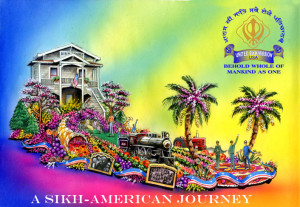 A national TV audience of millions and an enthusiastic crowd along the Pasadena parade route will get to see the first ever Sikh-themed float in the Rose Parade January 1, reports KPCC.
A national TV audience of millions and an enthusiastic crowd along the Pasadena parade route will get to see the first ever Sikh-themed float in the Rose Parade January 1, reports KPCC.
Members of the United Sikh Mission which is sponsoring the float along with SikhLens, Khalsa Care Foundation, SALDEF (Sikh American Legal Defense and Education Fund), and individuals have personally felt the sting of racism and hatred directed at them after September 11.
“I knew it was coming from a place of frustration of what had happened,” said Bhajneet Singh, 33, of La Cañada Flintridge. “I was frustrated too.”
The groups hope by telling their story of life for Sikhs in America, their community will bridge greater understanding with others.
The sponsoring groups recently released a timeline highlighting some of the big moments in Sikh American history.
1899-1917: Sikhs begin to migrate to California working as laborers and farmers; migration was severely curtailed by Immigration Act of 1917 (a.k.a. Asiatic Barred Zone Act). Legal migration from Asia ended with the National Origins Act of 1924.
September 4, 1907: A lynch mob of several hundred attack and rob the homes of Sikh millworkers in Bellingham, Washington.
October 24, 1912: The first Sikh American Gurdwara is founded in Stockton, California.
1913: The Ghadar party—an independence movement from British colonialism—was founded in Astoria, Oregon; California Alien Land Law of 1913 bars Souths Asians and other groups from owning property.
1920: Sikhs march in New York City’s St. Patrick’s Day Parade wearing green turbans and carrying signs that read: “300,000,000 of India with Ireland to the last” because “our cause is a common cause,” demanding unconditional independence for India and Ireland.
1923: In United States v. Bhagat Singh Thind, the U.S. Supreme Court rules that Thind— a U.S. Army veteran who sought naturalization— was “not white” and could not become a U.S. citizen. Asians were barred from citizenship until the Luce-Celler Act of 1946 is signed into law allowing Indians to naturalize and become citizens.
January 3, 1957: Dalip Singh Saund from San Joaquin, California (C.A.’s 29th Congressional District) becomes the first Sikh American and APIA elected (in 1956) to the U.S. Congress.
1965: The Immigration and Nationality Act of 1965 lifts restrictions and exclusions, allowing Asians to immigrate the to U.S.
1981: Sikhs are barred from serving with their articles of faith in the U.S. Military—despite the extensive participation of Sikhs in both World Wars— ending a long-standing religious accommodation. As of today, three Sikh American soldiers have been given exemptions to serve with their articles of faith.
September 15, 2001: Balbir Singh Sodhi, a Sikh American gas station owner, was shot five times and killed, becoming the first American to lose their life as a result of a hate crime after September 11th.
October 2008: Jaspreet Kaur Saini becomes the first Sikh American female lawyer in the Armed Services (Navy JAG).
May 2012: Washington, D.C. becomes the first major city in the U.S. to allow Sikh American police officers to serve with their articles of faith.
August 5, 2012: A white supremacist gunman, Wade Michael Page, attacked a gurdwara in Oak Creek, Wisconsin, killing six Sikh American members, and injuring four others, in the deadliest attack on a place of worship since the Jim Crow Era.
You can read more about how the Sikh-themed float came about on KPCC.

